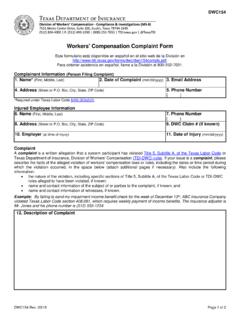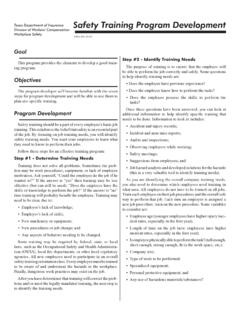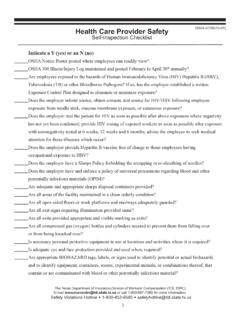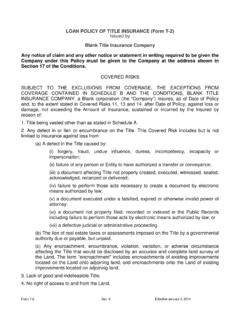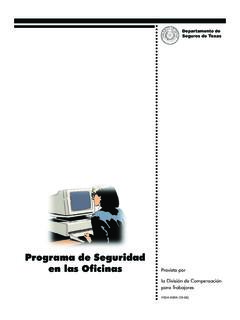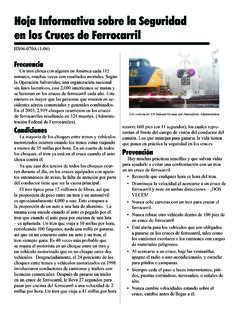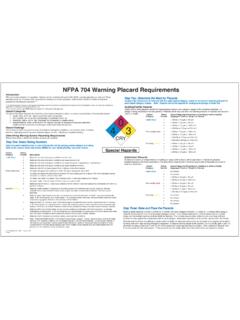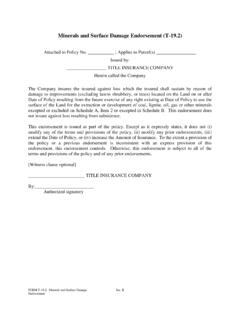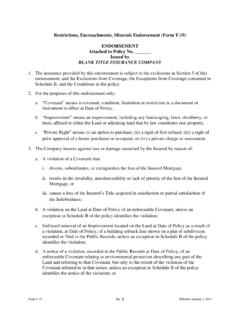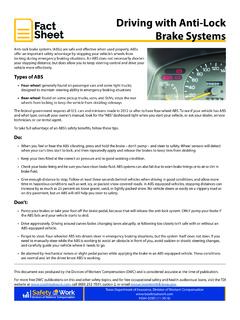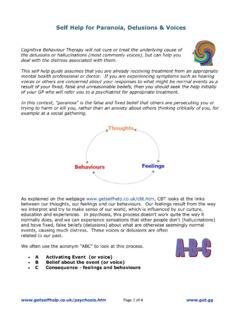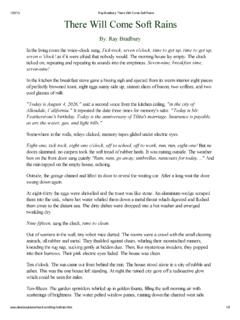Transcription of Noise and Hearing Protection Fact Sheet
1 Noise and Hearing Protection Fact Sheet One in 10 Americans has a Hearing loss that affects his or her ability to understand normal speech. Excessive Noise exposure is the most common cause of Hearing loss. Some workers with long-term Hearing loss have developed ways of adapting to the gradual onset of the disease. The effect of Noise is real and can be devastating. Workers who also develop tinnitus (constant ringing in the ears) can find this to be unbearable. The important thing is that no matter what your present level of Hearing loss, it is never too late or too hard to prevent further damage. Workers who already have serious Hearing loss have even greater reason for saving the Hearing they have left. The following information should provide reasons for eliminating Noise hazards at work and in everyday life. How Does the Ear Work? The ear has three main parts: the outer, middle, and inner ear. The outer ear (the part you can see) opens into the ear canal.
2 The eardrum separates the ear canal from the middle ear. Small bones in the middle ear help transfer sound to the inner ear. The inner ear contains the auditory ( Hearing ) nerve, which leads to the brain. Any source of sound sends vibrations or sound waves into the air. These funnel through the ear opening, down the ear canal, and strike your eardrum, causing it to vibrate. The vibrations are passed to the small bones of the middle ear, which transmit them to the Hearing nerve in the inner ear. Here, the vibrations become nerve impulses and go directly to the brain, which interprets the impulses as sound: music, a slamming door, a voice , etc. When Noise is too loud, it begins to kill the nerve endings in the inner ear. As the exposure time to loud Noise increases, more and more nerve endings are destroyed. As the number of nerve endings decreases, so does your Hearing . There is no way to restore life HS04-050C (10-20) to dead nerve endings; the damage is permanent.
3 How Does Noise Affect Hearing Loss? Can Noise Really Hurt My Ears? Yes, Noise can be dangerous. If it is loud enough and lasts long enough, it can damage your Hearing . Hearing damage can be caused by several factors other than Noise , but Noise -induced Hearing loss is different in one important way, it can be reduced or prevented altogether. Can I Toughen Up My Ears? No. If you think you have grown used to a loud Noise , it probably has damaged your ears, and there is no treatment no medicine, no surgery, not even a Hearing aid that completely restores your Hearing once it is damaged by Noise . How Can I Tell If a Noise Is Dangerous? sPeople differ in their sensitiv-ity to Noise . As a general rule, Noise may damage your hear-ing if you have to shout over background Noise to make yourself heard, the Noise hurts your ears, it makes your ears ring, or you have difficulty Hearing for several hours after exposure to the Noise . Sound can be measured scien-tifically in two ways.
4 Intensity, or loudness of sound, is mea-sured in decibels. Pitch is mea-sured in frequency of sound vibrations per second. A low pitch, such as a deep voice or a tuba, makes fewer vibrations per second than a high voice or violin. Sound in the workplace can be measured with a Type II sound level meter (accurate to within one decibel) and a field calibrator. A less expensive, but less accurate alternative is a sound level meter available as a smartphones app. What Does Frequency of Sound Vibration Have to Do with Hearing Loss? Frequency is measured in cycles per second, or Hertz (Hz). The higher the pitch of the sound, the higher the frequency. Young children, who general-ly have the best Hearing , can often distinguish sounds from about 20 Hz, such as the low-est note on a large pipe organ, to 20,000 Hz, such as the high hrill of a dog whistle that many people are unable to hear. Human speech, which ranges from 300 to 4,000 Hz, sounds louder to most people than noises at very high or very low fre-quencies.
5 When Hearing impairment begins, the high frequen-cies are usually lost first, which is why people with Hearing loss often have difficulty Hearing the high-pitched voices of women and children. Loss of high frequency Hearing also can distort sound, so that speech is difficult to understand even though it can be heard. People with Hearing loss often have difficulty detecting differences between certain words that sound alike, especially words that contain S, F, SH, CH, H, or soft C sounds, because the sound of these consonants is in a much higher frequency range than vowels and other consonants. What Are Decibels? Intensity of sound is measured in decibels (dB). The scale runs from the faintest sound the human ear can detect, which is labeled 0 dB, to over 180 dB, the Noise at a rocket pad during launch. Decibels are measured logarithmically. This means that as decibel intensity increases by units of 10, each increase is 10 times the lower figure.
6 Thus, 20 decibels is 10 times the intensity of 10 decibels, and 30 decibels is 100 times as intense as 10 decibels. Decibel Scale Faintest sound heard by human dB FaintFaint Whisper, quiet dB Normal conversation, sewing machine, dB ModerateModerateLawnmower, shop tools, truck traffic; 8 LoudLoudhours per day is the maximum exposure to protect 90% of dB Chainsaw, pneumatic drill, snowmobile; 2 hours per day is the maximum exposureVery LoudVery Loud without dB Sandblasting, loud rock concert, auto horn; 15 minutes per day is the maximum exposure without dB Max. Unprotected ExposureMax. Unprotected Exposure Gun muzzle blast, jet engine; Noise causes pain and even brief exposure injures unprotected ears. Maximum allowed noise140 dB Threshold of Painhreshold of Pain with Hearing protectors. Texas Department of Insurance, Division of Workers Compensation HS04-050C (10-20)2 How High Can the Decibels Go without Affecting My Hearing ?
7 Many experts agree that continual exposure to more than 85 decibels is dangerous. Hearing Protection is advised for sound at or above 85 decibels. Does the Length of Time I Hear a Noise Have Anything to Do with the Danger to My Hearing ? It certainly does. Impact sounds such as those pro-duced by gunshots and stamping presses are partic-ularly damaging to Hearing . High-powered rifles generate impact sounds in two ways: from the explosion of the powder charge and the su-personic crack of the bullet departing the barrel. Also, the closer an individual is to the source of intense Noise , the more damaging it is. Every gunshot produces a Noise that could damage the ears of anyone in close hear-ing range. Large bore guns and artillery are the worst because they are the loud-est. But even cap guns and firecrackers can damage your Hearing if the explosion is close to your ear. Anyone who uses firearms without some form of ear Protection risks the potential for Hearing loss.
8 Recent studies show an alarm-ing increase in Hearing loss in youngsters. Evidence suggests that loud music along with increased use of portable radios with earphones may be responsible for this phenomenon. Can Noise Affect More Than My Hearing ? A ringing in the ears, called tinnitus, commonly occurs after Noise exposure, and it often becomes permanent. Some people react to loud Noise with anxiety and irritability, an increase in pulse rate and blood pressure, or an increase in stomach acid. Very loud Noise can reduce efficiency in performing difficult tasks by diverting attention from the job. Noise Pollution and Workplace Safety Who Should Wear Hearing Protectors? If you must work in an excessively noisy environment, you should wear protectors. You should also wear them when using power tools, noisy yard equipment, firearms, or riding a motorcycle or snowmobile. What Are the Laws for on-the-Job Exposure? Habitual exposure to Noise above 85 dB will cause a gradual Hearing loss in a significant number of individuals, and louder noises will accelerate this damage.
9 For unprotected ears, the allowed exposure time decreases by one-half for each 5 dB increase in the average Noise level. For instance, exposure is limited to 8 hours at 90 dB, 4 hours at 95 dB, and 2 hours at 100 dB. The highest permissible Noise exposure for the unprotected ear is 115 dB for 15 minutes/day. Any Noise above 140 dB is not permitted. The Occupational Safety and Health Administration (OSHA), Standards 29 Code of Federal Regulations (CFR) (General Industry) and 29 CFR (Construction Industry) states that each employer will implement and maintain a written Hearing Conservation Program for their respective industries. In order to determine if a Hearing conservation program is needed, a site Noise evaluation must be done. This can be accomplished by conducting a Noise evaluation, Noise monitoring, or Job Hazard Analysis (JHA). If during these tests a Noise is found to be 85 dB or higher, a written conservation program will need to be written.
10 OSHA requires a yearly Hearing test for the approximately five million workers exposed to an average of Texas Department of Insurance, Division of Workers Compensation HS04-050C (10-20) 3 85 dB or more of Noise during an 8-hour workday. If Noise is found to be greater than 95 dB, hazard controls must be used. All persons should be reminded that OSHA Standards represent statutory minimums. An employer may exceed these minimums, and at times must do so to ensure employee safety. This might entrail mandating Hearing Protection at or above 85 decibels. Ideally, noisy machinery and workplaces should be engineered to be more quiet or the worker s time in the Noise should be reduced; however, the cost of these actions is often prohibitive. As an alternative, individual Hearing protectors are required when Noise averages more than 90 dB during an 8-hour day. When Noise measurements indicate that Hearing protectors are needed, the employer must offer at least one type of earplug and one type of earmuff without cost to employees.
